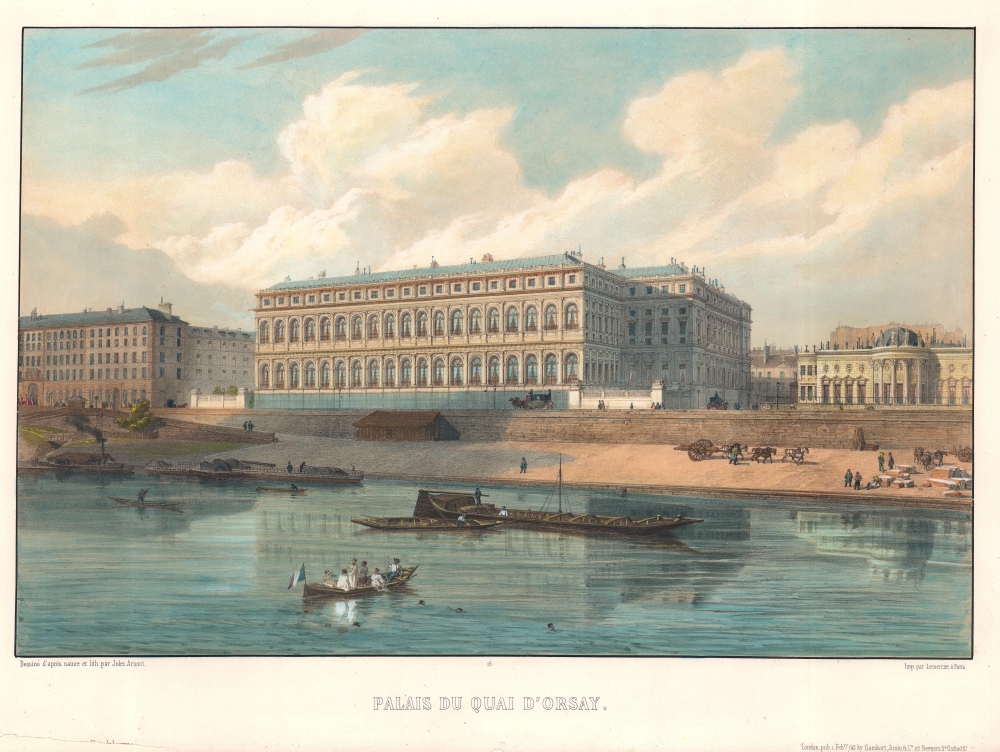This item has been sold, but you can get on the Waitlist to be notified if another example becomes available, or purchase a digital scan.
1845 Arnout View of the Palais du Quai d'Orsay, Paris, France
PalaisQuaiOrsay-arnout-1845
Title
1845 (dated) 13 x 17.25 in (33.02 x 43.815 cm)
Description
The Palais du Quai d'Orsay
Construction on the Palais du Quai d'Orsay began in 1810 under Napoleon, but was not completed until 1840 when the French Council of State (Conseil d'État) moved in. The building was set ablaze during the Paris Commune on the night of May 23-24, 1871, and its ruins remained along the Quai as a reminder of the Commune and the violence of civil war. In 1899, as Paris prepared for the 1900 World's Fair, city officials decided that a train station needed to be built closer to the fairgrounds, the Champ de Mars. This led to the construction of the Gare d'Orsay on the site of the destroyed Palais du Quai d'Orsay, better known today as the Musée d'Orsay, which is visited by millions annually.Publication History and Census
This view was drawn 'from life' by Jules Arnout, printed by Rose-Joseph Lemercier, and published by Gambart, Junin, and Company in February 1845. We note cataloged examples as being part of the collections at the Musée Carnavalet in Paris and the British Museum in London.CartographerS
Louis-Jules Arnout (June 1, 1814 - September 26, 1882) was a French artist, painter, and lithographer active during the mid-19th century. His father, Jean-Baptiste Arnout (June 24, 1788 - October 5, 1873), taught Jean-Louis the art of lithography as well as painting and other art forms. Arnout created works depicting landscapes and French, Swiss, Italian, and English cities. He displayed his work at the Paris Salon in 1852 and 1865. He died in Toulouse. He had one son, Auguste-Paul Arnout. More by this mapmaker...
Rose-Joseph Lemercier (June 29, 1803 - 1887) was a French photographer, lithographer, and printer. One of the most important Parisian lithographers of the 19th century, Lemercier was born in Paris into a family of seventeen children. His father was a basket maker, and he even began working as a basket maker at the age of fifteen, but Lemercier was drawn to lithography and printing and soon entered into an apprenticeship with Langlumé, where he worked from 1822 until 1825. After working for a handful of other printers, Lemercier started his own firm in 1828 at 2, rue Pierre Sarrazin with only one printing press. He subsequently moved a few more times before arriving at 57, rue de Seine, where he founded the printing firm Lemercier and Company. He created the firm Lemercier, Bénard and Company in 1837 with Jean François Bénard. Lemercier bought out Bénard's share in the firm in 1843 and, since his two sons died at a young age, he decided to bring his nephew Alfred into the business beginning in 1862, who would progressively take on more and more responsibility in running the firm. Between 1850 and 1870, Lemercier's firm was the largest lithographic company in Paris. The firm began to decline in prestige in the early 1870s, and, after Lemercier's death in 1887, its descent only quickened. It is unclear when the firm closed, but Alfred directed the firm until his death in 1901. Learn More...
Henri Jules Jeannin (fl. 1829 - 1854) was a French print publisher active in Paris in the mid 19th century. Jeannin maintained offices at No. 20, Rue du Croissant in Paris from 1829 - 1835 and then move is office to No. 20, Place du Louvre in Paris. Little else is known about Jeannin. Learn More...
Jean Joseph Ernest Theodore Gambart (October 12, 1814 - April 12, 1902) was a Belgian-born English art dealer and publisher who eventually grew to dominate the London art world in the mid-nineteenth century. Born in Kortrijk, Belgium, Gambert was the son of a bookseller, binder, and printer. He moved to Paris before he was nineteen and established his own print and papermaking business. He moved to London in 1840 to establish a branch there for the well-established print publishing company Goupil. In 1842 he established his own firm yet again, forming a partnership with a Mr. Junin, and their firm Gambart and Junin specialized in importing art prints from Europe. By 1844, the company had established itself as print publishers as well as importers and exporters. Gambart quickly became known as a leading art print publisher, and gained a reputation for fair and mutually beneficial agreements with artists. By 1849 Gambart expanded to include original works. Gambart was one of the first to establish an art gallery as they are recognized today, creating relationships between himself and artists and art buyers. Before his exhibitions at his gallery, art was generally sold directly from the artist to the buyer, who was often a patron. Gambart married three times but did not have any children. In 1846, he became a British subject. Gambert retired in 1870 and handed the business over to his nephew, Léon Henri Lefèvre,l who continued the business, and the Lefevre Gallery existed in London until 2002. Gambart moved to Nice with his third wife, whom he married when she was sixteen years old, and he died in 1902. Learn More...

